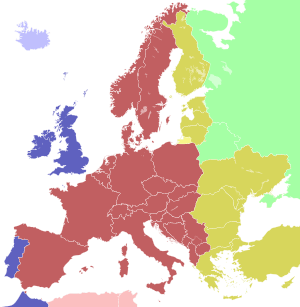Time in Europe

| light blue | Western European Time (UTC+0) |
| blue | Western European Time (UTC+0) Western European Summer Time (UTC+01:00) |
| pink | Central European Time (UTC+01:00) |
| red | Central European Time (UTC+01:00) Central European Summer Time (UTC+02:00) |
| yellow | Kaliningrad Time (UTC+02:00) |
| golden | Eastern European Time (UTC+02:00) Eastern European Summer Time (UTC+03:00) |
| light green | Minsk Time, Moscow Time (UTC+03:00) |
Europe spans 7 primary time zones (5 of them can be seen on the map in this article, while 2 other zones contain the European part of Kazakhstan and some very eastern territories of European Russia). Most European countries use daylight saving time and harmonise their summer time adjustments. See Summer time in Europe for details.
The time zones actually in use in Europe differ significantly from their "pure" theoretical variants as used for example under the nautical time system. Theoretically the world is divided into 24 time zones of 15 degrees. However, due to geographical and cultural factors it is not practical to divide the world so evenly and actual time zones may differ significantly from their theoretical borders. In Europe's case, the widespread use of the Central European Time Zone causes a major distortion in some areas from the theoretical time or the solar time. CET is theoretically centred on 15°E. However, Spain lying almost entirely in the Western hemisphere, and France with some regions to the west should theoretically use UTC, as they did before the Second World War.[1] The general result is a solar noon which is much later than clock noon. This results in later sunrises and sunsets than should theoretically happen. The Benelux countries should also theoretically use GMT.
Russia and Belarus have observed "permanent summer time" between March 2011 and October 2014[2] and "permanent winter time" since October 2014. Iceland can be considered to be on "de facto" permanent summer time because, since 1968, it uses UTC time all year, despite being located more than 15° west of the prime meridian. It should therefore be located in UTC-1, but chooses to remain closer to continental European time, resulting in legal times significantly in advance of local solar time.
[[File:Tzdiff-Europe-winter.png|220px|thumb|This map shows the difference between legal time and local mean time in Europe during the winter. Most of Western Europe and European Russia is significantly ahead of local solar time.
]] |
[[File:Tzdiff-Europe-summer.png|220px|thumb|This map shows the difference between legal time and local mean time in Europe during the summer. Most of Western Europe is significantly ahead of local solar time.
]] |
Time zones
| Time of Day | Common Time Zone Name | Coordinated Universal Time | Daylight savings time |
|---|---|---|---|
| 18:24, May 2, 2015 GMT / BST () | Greenwich Mean Time (GMT) Western European Time (WET) | UTC | UTC+1 |
| 19:24, May 2, 2015 CET / CEST () | Central European Time (CET) | UTC+1 | UTC+2 |
| 20:24, May 2, 2015 EET () | Eastern European Time (EET) | UTC+2 | UTC+3 |
| 20:24, May 2, 2015 MSK () | Moscow time (MSK) | UTC+3 | UTC+3 |
Of the 28 EU member states, 3 use Western European Time (Ireland, Portugal and the United Kingdom) and 8 use Eastern European Time (Finland, Estonia, Latvia, Lithuania, Romania, Bulgaria, Greece and Cyprus). The other 17 member states all use Central European Time.
References
- ↑ Poulle, Yvonne (1999). "La France à l'heure allemande" [France on German time] (PDF). Bibliothèque de l'école des chartes 157 (2): 493–502. Retrieved 11 January 2012. (French)
- ↑ Parfitt, Tom (25 March 2011). "Think of the cows: clocks go forward for the last time in Russia". The Guardian. Retrieved 5 January 2012.
| ||||||||||||||||||||||||||||||||
| ||||||||||||||